

CHICAGO’S BEST NEW PRIVATE DINING ROOMS
Here are nine places you can book for a casual business lunch, a post-work happy hour or a more formal affair. | PAGE 19



Here are nine places you can book for a casual business lunch, a post-work happy hour or a more formal affair. | PAGE 19
Cristina Pacione-Zayas believes government has a role in righting historic wrongs
In Washington, the power brokers of old were JFK and FDR. On Capitol Hill today, congressional gossip buzzes around AOC and MTG. In Chicago politics, the three-letter acronym you need to know now is CPZ.
Cristina Pacione-Zayas, or CPZ, as you’ll hear around the fth oor of City Hall, was appointed as Mayor Brandon Johnson’s new chief of sta at the beginning of this month. Before her promotion, she served as Johnson’s deputy chief of sta . In that role, her acronymic moniker became well known in part as she took the helm of the city's migrant response — a task that raised her pro le while also making her a lightning rod as the Johnson administration struggled to deal with the in ux of asylumseekers being bussed in from Texas.

Jason Lee, who is known to throw his weight around City Council members with a bluster mimicking the Machine days of old-school, Chicago horse trading.
She is the lone Latina inside the male-dominated “Core Four” — a group that until March included her predecessor in the chief of sta role, Rich Guidice, as well as city Chief Operating O cer John Roberson and senior adviser


Restaurateur’s plan for a dining and entertainment complex on Goose Island is scrapped. PAGE 3
By contrast, politicians and colleagues describe PacioneZayas as assertive yet compassionate. She is a selfdescribed Type A personality, one who is armored with an electronic writing tablet where she takes detailed notes. Her former colleague in the Illinois Senate, state Sen. Omar Aquino, described the first time she presented a


PAGE 13



Fight over a signage law has exposed an ongoing feud between the Cubs and a nearby rooftop owner. PAGE 8


Natural gas is fueling a ght between consumer advocates, a powerful utility company and the state. Amid competing advertising campaigns, accusations of mismanagement and state decarbonization e orts, the Illinois Commerce Commission is starting a process that will shape how the state regulates the increasingly controversial industry.
While Chicago considers passing an ordinance that would e ectively ban natural gas in some new building construction — following the lead of places like New York City and Seattle — state o cials are moving more slowly in an attempt to ensure Illinois meets its goal of having 100 percent renewable energy by 2050.
e ICC launched a process dubbed the “Future of Gas” this month that will inform the governor, legislature and other policymakers on potential policy changes. e process was initiated by the ICC after they tamped down requests for rate increases from all of the state’s major gas utilities.
“We need to get this right,” ICC Chair Doug Scott said at a virtual workshop with over 350 advocates and industry o cials this month. “We get one really good shot at this.” He added the process “is not designed to meet a pre-ordained conclusion.”
Rob Kelter, senior attorney at the Environmental Law and Policy Center, praised the new approach to regulation and Scott’s personal attention to the proceeding while welcoming the fact that these discussions are happening outside of a traditional rate case, where utilities have more say in setting the agenda.
“Everybody pays gas and electric bills and also everyone is affected by the current gas and electric systems,” Kelter said.
Both electric and gas companies are involved with the “Future of Gas” proceeding, which is expected to last until summer 2025, although the precise timeline and the scope of what will be discussed are still tentative.
“What I hope will result from this is a lot of good, productive discussion that objectively analyzes the state’s options for reducing carbon emissions,” Kelter said.
A spokesperson for Peoples Gas, Chicago’s natural gas utility, echoed that sentiment and added the state’s gas distribution system will play a major part in reaching the state’s climate goals.
“Natural gas, along with emerging technologies such as Renewable Natural Gas and Hydrogen, will be critical to meeting Chicagoans’ need for reliable, a ordable, decarbonized energy,” Peoples Gas’ David Schwartz told Capitol News Illinois in a statement.
Schwartz pointed to technological developments in capturing natural gas from waste products

like food, using new gas-powered appliances for heating buildings and the ongoing replacement of pipes as steps that would reduce or even eliminate the gas system’s carbon footprint.
But Kelter said he is skeptical of the claims made by boosters of the new technology — a position shared by other environmental and consumer advocates.
“ e state has climate goals that require us to change how we heat and cool our homes,” he said. “We’ve got to move toward a system that’s reliant on renewable energy.”
While the ICC weighs the future of the gas system generally, it’s also investigating the current state of Peoples Gas. e company’s controversial “safety modernization program,” designed to replace Chicago’s aging pipe infrastructure, was put on notice in November, when the ICC paused any spending related to the program and began an investigation into it. at investigation began in earnest this month, with Peoples Gas ling its rst testimony in the case. e company was also granted a rehearing on the decision to pause spending after it claimed some work was still necessary.
e investigation is expected to last until January 2025, while the rehearing will last until late May or early June 2024.
Consumer advocates have praised the decision to shorten the leash on Peoples Gas’ pipe replacement program, while also recognizing the need to replace Chicago’s natural gas pipes — some of which are more than 100 years old.
But Abe Scarr, the head of the consumer advocacy group Illinois PIRG, said the program’s costs have grown, in part, due to Peoples Gas conducting other work under the guise of replacing old
pipes or “emergency” repairs.
“I think it’s pretty clear Peoples Gas hasn’t really kept to the scope of that work,” Scarr said.
Schwartz, of Peoples Gas, said the company provided options to the ICC for reducing the scope of the work or more narrowly targeting the program when the company can begin work again.
“We will continue to seek authorization to move forward with the needed work,” Schwartz said. “Modernization of Chicago’s underground energy delivery system is crucial for the safety, reliability, affordability and environmental sustainability of
Since the ICC’s bombshell rulings in November limiting several utilities’ rate requests and investigating Peoples Gas, one labor union launched a pressure campaign on the commission and the governor urging them to walk back some of the decisions.
e International Union of Operating Engineers Local 150, which represents about 23,000 members in Illinois and neighboring states, launched a series of advertisements claiming that the decisions were a “natural gas ban”
and urged prioritizing pipeline safety in the transition to a cleaner energy system.
“I don’t think any of us have seen enough facts in front of us to say that the natural gas system will be obsolete,” Local 150 spokesperson Kristine Kavanagh told Capitol News Illinois.
Because of the decision to pause Peoples Gas’ infrastructure spending, Kavanagh said about 200 members of her organization lost their jobs in addition to hundreds more in other unions.
While the union endorsed Pritzker in his most recent general election in 2022, his campaign organization launched a series of response ads pushing back on the union’s claims.
“At a time when too many working families are struggling to pay their heating bills, the governor knows that putting their bottom line ahead of that of a recordpro t-earning utility is the right thing to do,” Pritzker campaign spokesperson Christina Amestoy said in a written statement.
e back-and-forth ads between the union and the Pritzker campaign illustrate a potentially growing ght between the governor and one of the Democratic Party’s core bases of support.
Capitol News Illinois is a nonpro t, nonpartisan news service covering state government. It is distributed to hundreds of print and broadcast outlets statewide. It is funded primarily by the Illinois Press Foundation and the Robert R. McCormick Foundation, along with major contributions from the Illinois Broadcasters Foundation and Southern Illinois Editorial Association.
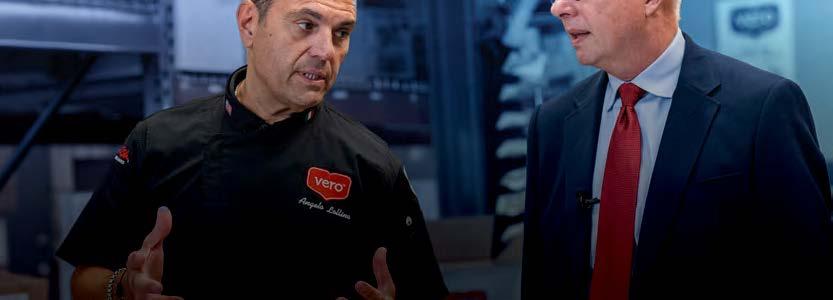





In the Great Lakes region, deals in 2024 dropped 27% from the same time a year ago and was the slowest rst quarter in a decade
the first quarter of 2023 and the slowest first quarter in 10 years.

In May, the innovative glass structure in Plano will mark its 20th anniversary of being open to the public |
By Dennis RodkinThis spring, with the 20th anniversary of the rescue of a masterpiece of modern architecture, there’s a second rescue to celebrate: the restoration of its rst owner, Edith Farnsworth, to a central spot in the narrative of the riverside country house that Ludwig Mies van der Rohe designed for her.
On May 1, 2004, when the tranquil glass and steel pavilion built in 1951 in Plano opened to the public, “the story was about the great man, the architect and what he had created,” said Michelangelo Sabatino, an architectural historian and professor at the IIT College of Architecture.
See FARNSWORTH on Page 26
Giving Farnsworth her rightful credit extended to renaming the landmark in 2021 to include her rst name and rewriting the script of
tours.
Activity in the private-equity sector slowed in the first quarter of 2024 as investors remained wary of the U.S. economic recovery and high interest rates kept the cost of making deals too high for most investors.
“We are certainly not off to the races,” said Tim Clarke, senior private-equity analyst at PitchBook. “Everything is focused on existing holdings . . . kicking the can down the road, just kind of muddling through.”
The U.S. Federal Reserve’s decision to hold interest rates steady so far this year was the key impediment to an expected rebound in deal volume, roiling expectations for a surge in buyouts of private companies.
And the lack of cuts during the first three months of the year will likely continue to cast a pall over deal-making throughout 2024 as the central bank is unlikely to lower borrowing costs fast enough to match the six rate cuts that some forecasters had predicted at the end of 2023.
“I don’t think that the dam will be burst,” Clarke said. “I think it is still a painful cost of capital.”
On the private-equity front, 1,382 deals were made during the first quarter, according to PitchBook. That was down from 1,978 a year earlier. In the Great Lakes region, there were just 200 deals, a drop of 27% from
A survey of 10 of the biggest private-equity firms in the Chicago area showed eight deals announced during the first three months of the year, up from seven a year earlier. The firms are not required to announce their investments.
“We are certainly not off to the races. Everything is focused on existing holdings . . . kicking the can down the road, just kind of muddling through.”
Tim Clarke, senior private-equity analyst at PitchBook
Uncertainty about geopolitical events such as the upcoming U.S. presidential election, the Russia-Ukraine war and especially concerns that the Israel-Hamas war could spread across the Middle East also have contributed to the slow pace of deal-making.
And U.S. economic indicators have not done enough to shore up investor concern that the possibility of a recession is off the table.
“The data is kind of going
See PRIVATE EQUITY on Page 26
R2 sold the site that Brendan Sodikoff had eyed for a dining and entertainment complex
Chicago developer R2 has scrapped plans to build a dining and entertainment complex with restaurateur Brendan Sodiko on a former Goose Island boat yard, selling the property to a local real estate investor that planted its ag next door last year.
A venture of Chicago-based BA Investment Advisors paid nearly $5.8 million last month for a portion of the site at 934 N. North Branch St., according to Cook County property records.
e vacant parcel is part of a 3.5-acre former boat yard that an R2 venture owned for nearly a decade and had planned to develop with a riverfront restaurant and bar in partnership with Sodiko , founder and CEO of Chicago-based Hogsalt Hospitality. Property records show R2 sold o the northwest portion of the site last year for $4.8 million to a venture of luxury car dealer Joe Perillo.
e sales close the book on a project that signaled Goose Island’s shift away from its indus-

trial past into a mixed-use enclave where people could work, eat and even live. City zoning changes in 2017 opened up the North Branch Industrial Corridor to a wide mix of new uses, prompting developers to snap up development sites on 760 acres along the river from Kinzie Street to Fullerton Avenue.
Some new o ce users have moved to Goose Island since then, and R2 co-led a redevelopment of the former Morton Salt warehouse across the river from Goose Island into a music venue. But Goose Island itself, which remains restricted by its zoning as a
The report is evidence that high-pro le attention is whittling away at a fundamental piece of the racial wealth gap
e number of real estate appraisers basing a property’s value in part on race, national origin or other personal characteristics declined sharply in recent years, according to a new report from one of the major housing nance agencies.
The report is evidence that high-profile attention to the issue of racial bias in appraisals, coming from such sources as the White House, the real estate industry and the Chicago-based Appraisal Institute, is whittling away at a long-standing problem that is a fundamental piece of the racial wealth gap.
Between 2021 and 2023, the incidence of bias that Fannie Mae spotted in appraisals dropped by 80%, according to its quarterly report, released at the end of March. Fannie Mae is one of the two giant governmentsupported enterprises that back mortgage loans.
Since 2021, when the issue of racial bias in appraisals came to light as a widespread problem, Fannie Mae has been scanning appraisal reports for signs of bias. e signs include an appraiser attributing part of a property’s value to race, sex, religion, dis-

about 0.15% of the appraisals it scanned. Two years later, the figure was 0.03%, or about onefifth the 2021 figure.
Between 2021 and 2023, the incidence of bias that Fannie Mae spotted in appraisals dropped by 80%, according to its quarterly report.
ability or other statuses that are federally protected.
In 2021, the report says, Fannie Mae found signs of bias in
e report says Fannie Mae spotted about 1,500 cases of bias in 2021, but it does not provide a gure for 2023. e previously mentioned percentages suggest the number of cases spotted in 2023 was about 300.
“I do agree that there’s a heightened level of awareness that has helped change things,” said Don Robinson, a Coldwell Banker agent
in Chicago who has been a leading local advocate for eliminating racial bias in appraisals. But Robinson said the move does nothing to correct past mistakes that put a lid on Black communities’ improvement and Black homeowners’ household wealth.
‘No retribution’
The decline of bias, Robinson said, “is going to prevent future harm, but there’s no retribution for the people who have been harmed.” A Brookings Institution report estimated that Black communities have a deficit of about $240,000 in median household wealth compared to
White households.
As The Washington Post and others documented a few years ago, Black homeowners often found that an appraiser would assign a lower home value to a house where family portraits on display showed Black faces. And when looking for comparable properties for the appraisal of a Black-owned house in a majority-white neighborhood, appraisers would reach across geographical space to compare the house only to those in majority-Black neighborhoods.
The Fannie Mae report details a healthy learning curve in the appraisal industry. Each
time it finds bias in an appraisal, Fannie Mae sends a letter to the appraiser responsible, explaining the violation.
A little more than 20% of the appraisers who received letters in 2021 violated the standards again in 2022, the report said. But of those who received violation letters in 2022, only 9% showed bias in their appraisals again in 2023.
“These statistics highlight the remarkable progress appraisers have made in becoming more objective,” the report said, “and in eliminating consideration of protected class.”
The appraisal industry has been working diligently to effect change. In 2018, the Appraisal Institute joined the mortgage backers and the Urban League in launching the Appraiser Diversity Initiative, an effort to attract more diverse talent to the profession. It’s an intentional counterweight to the tradition in the appraisal business where veterans recruit their own newcomers, a selfselection system that tended to stifle the inclusion of outsiders.
“ e process by which someone becomes an appraiser has been a barrier to entry,” said Sanina Ellison Jones, managing broker at ReChrg, a Chicago real estate brokerage, and president of the Dearborn Realtist Board, a venerable organization of Black real estate professionals in Chicago. e group has been working with the Urban League and the Illinois Department of Financial & Professional Regulation to diversify the ranks of appraisers.
“We are trying to make sure there is more opportunity to become an appraiser, more of an entryway,” Ellison Jones said.
Investment in Chicago startups picked up in the first quarter, though the number of deals remains weak.
Chicago companies raised $805 million in venture capital in 69 deals, according to PitchBook. That compares to 85 companies raising $462 million in fourth-quarter 2023. In the first quarter last year, 95 companies raised $520 million.
Nationally, the amount raised was down 9% from the fourth quarter to $36.6 billion, with the number of deals down 17%, according to PitchBook.
In Chicago, the amount invested and the number of deals can fluctuate widely from quarter to quarter.
Both funders and founders are still feeling a hangover from the pandemic-fueled boom in 2021 and 2022, when massive amounts of capital flooded in, sending investments and valuations soaring. Companies now are facing lower valuations.
“For those raising for the second time, a flat round is better than a down round and a down round is better than no round,” says Marc Halpin, a Chicago startup veteran who now leads Kerosene Ventures, which helps connect founders with venture investors.
“2021 and ’22 were exceptions. For a founder who was in the market the last couple years, it may feel like 2024 is through the floor. It’s not great, but it’s in line with where the market has been.”
Funding levels in Chicago are about where they were between 2018 and 2020, when they averaged about $669 million a quarter. With 69 deals in the first quarter, deal count lagged the average of 85 deals.
One of the most closely watched Chicago deals last quarter involved Ocient, a software startup that raised $49.4 million.
Halpin says he’ll be watching the second quarter closely because Silicon Valley Bank, a major startup lender, failed near the end of the first quarter last year, sending a chill through the venture industry.
The second quarter “will be telling,” he says. “I’d like to think we’ll be up.”

Jim Murray, a former health insurance and managed care executive, joined the chain’s leadership team as president and COO
VillageMD, a nationwide chain of doctors’ o ces majority owned by Walgreens Boots Alliance, has added a new executive to its leadership team to kick-start growth and performance amid recent downsizing.
e Chicago-based company on April 10 announced that Jim Murray, a former health insurance and managed care executive, joined VillageMD as president and chief operating o cer on April 1. In this role, Murray will lead operations across VillageMD’s enterprise, which includes clinics under the Village Medical brand, as well as dozens under Summit Health and CityMD, which VillageMD acquired at the beginning of last year.
Across its hundreds of locations, VillageMD says it is now one of the largest providers of value-based care in the country, providing patients primary, urgent and multispecialty care. But Murray’s appointment comes as VillageMD has closed at least 140 clinics across seven states in recent months under direction from Walgreens, which holds a 53% stake in the company.
Deer eld-based Walgreens, which has worked for the past several years to establish an entirely new health care delivery segment, originally invested in VillageMD in 2020 with a plan to open as many as 700 clinics at Walgreens stores. However, under nancial pressure from poor performance quarter after quarter, Walgreens has moved to downsize the VillageMD footprint.
‘Money-losing business’
Walgreens CEO Tim Wentworth told investors on March 28 that VillageMD will be closing 160 clinics due to lower-than-expected performance stemming from slow patient growth and changes to Medicare reimbursement models.
VillageMD said in a press release announcing Murray’s appointment that it currently operates about 620 locations nationwide. But that’s down from about 870 clinics as of May 31, according to a June Walgreens earnings presentation. Of them, 217 were VillageMD clinics attached to Walgreens stores, or “co-located,” according to the presentation. It’s unclear exactly how many VillageMD clinics are still co-located.
VillageMD did not respond to a request for comment.
“ e market itself, for the business that VillageMD is in, has been tough,” said Brian Tanquilut, a health care services equity research analyst at Je eries. “ e companies are struggling in that space. eir valuations have gone down.”
Lackluster performance and a shrinking footprint hurt VillageMD’s value, too, leading Walgreens to take a $5.8 billion impairment charge last month on its two-part, $6.2 billion investment in VillageMD. e move revealed
Walgreens signi cantly overpaid for the asset.
“ ere are a lot of startup losses associated with an aggressive clinic opening strategy, especially in that value-based world,” Tanquilut said. “Village has been a cash burner and a money-losing business for Walgreens.”
Tanquilut estimates VillageMD lost $800 million last year. “ ose challenges have forced Walgreens to re-evaluate the strategy,” he added.


Clinic closures are leading VillageMD to exit some states altogether, including Illinois — its home state. Last month, the company disclosed it was laying o at least 50 workers across two of its six Illinois clinics, with more personnel cuts expected.
VillageMD is also exiting Florida, Indiana, Massachusetts, Rhode Island and Nevada. A Walgreens spokesman previously told Crain’s the companies are now focusing on maintaining VillageMD in mar-


kets like Houston, Phoenix and Atlanta, which could be the focus for Murray.
Before joining VillageMD, Murray was chief operating o cer and chief transformation o cer for St. Louis-based health insurance and care management provider Centene. Prior to that, he was president and COO of managed care services provider Magellan Health, which was acquired by Centene in 2022. Murray also previously held various executive


roles at Louisville, Ky.-based Medicare plan provider Humana for nearly 30 years.
“We have laid important groundwork to become one of the nation’s leading care platforms by providing high-quality, compassionate care with our patients’ best interests at the center,” VillageMD CEO and Chair Tim Barry said in a statement. “Jim will help advance us to (the) next level of clinical, nancial and operational performance.”













Landlords in the sector just endured the worst quarter of demand in nearly three years
Danny EckerSuburban o ce landlords just endured the worst quarter of demand in nearly three years, a continuation of the downsizing trend that has pushed the vacancy rate to another all-time high.
e share of available o ce space across the suburbs rose during the rst three months of the year to 30.8% from 30.2% at the end of 2023, according to data from real estate services rm Jones Lang LaSalle. e new vacancy rate is up from 28.5% one year ago and 22.1% when the COVID-19 pandemic began, having reached new record highs in 13 consecutive quarters.
e numbers paint an ugly picture of the suburban o ce landscape four years after the public health crisis turbocharged the rise of remote work. Companies shrinking their ofce footprints have slowly whittled away occupancy at o ce buildings, squeezing landlords’ bottom lines.
For tenants hunting for new leases, that means plenty of negotiating leverage. But a swelling amount of distressed buildings as landlords grapple with maturing debt is also making it di cult for companies to complete new leases and ensure building owners will hold up their end of the deal.
“We went from tenants not in
position to put deals together (early in the pandemic) to now landlords not being able to nalize deals,” said JLL Executive Vice President Scott Ohlander, who negotiates leases on behalf of companies in the suburbs. “I almost think the current environment is harder.”
In many cases, companies are looking to both reduce their footprints and get a commitment of cash to build out or upgrade their workspace. Landlords, meanwhile, are sitting on buildings that have seen their values battered by two years of rising interest rates and aren’t sure whether new capital commitments would be putting good money after bad.
Some owners have fully negotiated leases ready to move forward but are not completing them because they aren’t sure whether they’ll be able to renance their buildings or they’re handcu ed by lenders that won’t allow certain deal terms, Ohlander said.
“It just shows you that capital is tight, and decisions are challenging. ere are many more layers of approval right now from a landlord that you need to go through. It’s a time-consuming process,” he said.
At least one prominent suburban o ce building added to the pool of distress during the rst
quarter, as the owners of the four-building Oak Brook 22 complex next to Oakbrook Center mall surrendered the property to their lender. Yet another big suburban property emerged from distress: A Florida investor bought the Schaumburg Towers o ce complex from a lender that foreclosed on the pair of 20-story o ce buildings earlier this year.
A handful of staggering space cutbacks were the main culprit in pushing up vacancy to start the year. Bene ts administration company Alight moved out of its roughly 200,000-square-foot headquarters at 4 Overlook Point in north suburban Lincolnshire, shrinking its main ofce to just 16,000 square feet on the top oor of BMO Tower downtown. Chemical company CF Industries last quarter moved into its new 77,863-square-foot headquarters at 2375 Waterview Drive in Northbrook, a nearly 56% reduction from the 176,000square-foot building it just vacated in Deer eld.
Net absorption, a key demand metric showing the change in the amount of leased and occupied space compared with the prior period, fell by about 386,000 square feet during the rst quarter, according to JLL. at was the biggest drop-o in demand since the second quarter of 2021.
More of that space-shedding trend is likely still to come. ere are roughly 9 million square feet of o ce leases in the suburbs set to expire over the next three
Uber is adding taxis to its app in Chicago. Yes, you read that right.
The ride-hailing pioneer is now courting cabs here, following a path that it has taken in New York and other cities. Taxi drivers are wary.
Uber, often blamed for the decline of traditional taxis, now wants to give its users an option to hail a cab.
Users in Chicago began seeing a taxi option in the Uber app on April 11.
Why is Uber giving its customers the chance to take a traditional cab?
“We continue to believe that there is no world in which taxis and Uber exist separately — there is simply too much to gain for both sides,” the company said in a statement.
Taxi drivers are likely to be skeptical of a longtime nemesis.
“ e whole industry took a beating after the surge in rideshare,” says Furquan Mohammed, an attorney who helps cab-
bies and lenders with taxi medallion purchases. “I think (drivers) are very wary of how it’s going to work out. It’s been a very contentious relationship.”
Uber says it launched a similar program two years ago in New York, followed by pilot programs in San Francisco, Los Angeles, San Diego and Washington, D.C. The program gives its customers the ability to order a cab the way they order an Uber, the company says.
Uber partnered with Curb Mobility and Arro, which make the apps that gave taxis the ability to compete with ride-hailing upstarts by allowing taxi customers the ability to order and pay for a cab using a mobile phone.

years, JLL data shows. at is less than the 12 million that expired over the last three years, but still stands as a large group of companies that haven’t yet had their chance to change their o ce footprint in the wake of the pandemic. Ohlander said the number of tenants in the market for space has recently increased, suggesting there will be takers for space that others may leave behind. More people returning to o ces more regularly could also reduce the scope of the o ce downsizes companies look for, which would go a long way to help balance supply and demand. As companies get more removed from the pandemic, “I don’t necessarily think the (space) givebacks will be as dramatic as we’ve experienced in the past,” Ohlander said. O ce buildings being demolished or repurposed also stand
to cut down the vacancy rate. One of the biggest move-outs of the rst quarter came from Citigroup, which left behind 146,000 square feet at 50 NW Point in Elk Grove Village for less than 50,000 square feet at Schaumburg Corporate Center. But the building it vacated is part of an o ce park set to be razed and redeveloped with a pair of data centers, taking a chunk of o ce inventory out of the market.
“We’d love to see more of that, because there are (o ce) assets that are becoming obsolete,” Ohlander said. Yet with limits on electrical power to support data centers and industrial redevelopment slowing over the past year, developers’ appetite for transforming suburban o ce buildings may be weakening. “ ere are a lot more properties that should be on the chopping block. I just don’t know if they’re going to be able to nd a use.”
Because most cab drivers already have the software and equipment, they can simply opt in to receive ride requests from Uber users; those who do opt in can then choose whether to accept the fares or not.
“I don’t think it will help,” says Shoib Hasan, owner of Globe Taxi Association, which has a eet of about 100 cabs in Chicago. “ ey’ll want their cut.”
Uber didn’t specify exactly how the nancial structure will work for drivers, saying the fares are based on several variables and that its take also varies.
The New York Taxi Workers Alliance, a union that represents drivers and has sparred frequently with Uber, called the program a Trojan horse.
“Drivers aren’t really seeing an increase in trips as a result,

but they are losing income per trip, as Uber may charge the rider even more than the metered rate but drivers are paid far below it,” said Bhairavi Desai, the union’s president. Uber disputes that taxi drivers are paid less. It didn’t offer data on how its program has worked in other cities, such as New York, but said it’s happy with the usage levels by taxi
drivers and riders.
Taxi drivers are in a position to take a pass on Uber. Mohammed, the attorney who works on medallions purchases, estimates the number of taxi drivers in Chicago has dropped below 3,000 from about 7,000 at its recent peak. “There’s no shortage of people who need transportation, and there’s not enough taxis.”
HuFriedyGroup, founded in 1908, has about 1,500 employees across more than 20 global manufacturing facilities and other locations
Scott Suttell, Crain’s Cleveland BusinessMedical equipment and life sciences company Steris said it has agreed to sell its dental segment, based in Chicago, to Peak Rock Capital, a middle-market private investment firm, for $787.5 million in cash.
The deal will “allow us to focus on our customers within our core markets in health care, pharma and medtech who can most benefit from our full portfolio of products and services,” said Dan Carestio, president and CEO of Steris, in a statement.
Steris is based in Dublin, Ireland, but its U.S. operations are headquartered in Mentor, Ohio.
Steris said the transaction is structured as an equity sale and includes a potential additional earnout of up to $12.5 million, subject to the dental segment hitting certain revenue targets in fiscal 2025.
The dental segment, which is known as HuFriedyGroup and is based in Chicago, reported revenue of $407 million and contributed segment operating income of $86 million in the trailing 12-month period ended Dec. 31, 2023, Steris said. The dental segment was part of Steris’ $4.6 billion acquisition of Cantel Medical in 2021.
Steris said the deal is subject to customary closing conditions, including regulatory review, and is expected to close in the first quarter of fiscal 2025. The company said it intends to use deal proceeds “primarily to repay debt.” Reduced interest expense following the planned debt re-
payment will increase annual earnings by about 35 cents a share, Steris said.
Steris reported revenue of more than $4 billion for the nine months ended Dec. 31, and said it expects to complete the sale in the first quarter of its 2025 fiscal year, adding that the reduced interest expense following its planned debt repayment will boost annual earnings by about 35 cents a share.
The dental segment will be reported as discontinued operations for Steris’ fourth quarter and all of fiscal 2024. The company will provide an updated outlook for fiscal 2025 when Q4 results are released.
Peak Rock said HuFriedyGroup, founded in 1908, has brands including Hu-Friedy, Crosstex, Omnia and Accutron. It said the company serves customers in about 100 countries and has about 1,500 employees across more than 20 global manufacturing facilities and other locations.
Spencer Moore, managing director of Peak Rock, said in a statement, “HuFriedyGroup’s differentiated brands, high-quality product o erings, strong customer base and outstanding team make this a highly compelling investment opportunity. We look forward to partnering with the management team and employees to drive further new product innovation and accelerated organic growth.”
Steris stock closed Wednesday, April 10, at $209.21 per share. e stock’s 52-week high is $254, and the 52-week low is $180.54.


A ght over a signage law has exposed an ongoing feud between the team and a property owner across from Wrigley Field — and it has big implications for the organization’s relationship with city of cials |
The Chicago Cubs took a key step toward putting two big corporate logo signs atop buildings across the street from Wrigley Field. But their push for permission has exposed an ongoing feud with a neighbor that could have big implications for the team’s relationship with city o cials.
In a victory for the Cubs’ long-running e ort to extract more revenue out of the Friendly Con nes and its environs, the City Council Zoning Committee approved an ordinance on April 9 allowing the team to install two large LED signs on the rooftops of buildings that Cubs ownership controls just beyond the ballpark’s bleachers. e team unveiled plans last month to put a large Coca-Cola sign atop the building at 1040 W. Waveland Ave. and another for paint company Benjamin Moore on the roof of 3623 N. She eld Ave., two locations that are highly visible from inside the stadium.
e ordinance — introduced by 44th Ward Ald. Bennett Lawson and slated to proceed to the City Council for a nal vote this month — would create a “special sign district” governing the buildings beyond the bleachers and allow two rooftop signs speci cally on buildings controlled by the “Cubs organization or its principals or their a liates.” Ventures tied to the Ricketts family, which owns the franchise, have acquired many properties across the street from Wrigley along She eld and Waveland, buildings well known for their rooftop seating.
But while the measure sailed through the Zoning Committee, it didn’t sit well with Aiden Dunican, who owns a rooftop building at 1050 W. Waveland Ave. Attorney Tim Cerney, who represents Dunican, told committee members during a public comment
period of the meeting that the proposal “is an unfair ordinance to the other property owners in the area,” contending that property owners in the proposed sign district that are not a liated with the Cubs should have the same signage opportunity.
“ is is all for the Cubs and nothing for anybody else,” Cerney said before his comment time expired.
What was not discussed during the meeting is that Dunican and the Cubs have been battling behind the scenes recently over the Waveland property owner’s ability to keep operating its rooftop business or add any signage to the property in the future. at ght is shaping up to be one of the rst big tests in the Cubs’ relationship with Lawson, who became alderman of the 44th Ward just last year.
Speaking to Crain’s hours after the zoning meeting, Cerney revealed a new chapter in a long, contentious history of the Cubs’ relationship with rooftop owners. Out eld signage was at the heart of a battle about 10 years ago between the team and owners of several rooftop properties along She eld and Waveland who argued that new out eld video boards and signage the team was planning violated 20year revenue-sharing contracts they signed with the club in 2004. ose agreements allowed the rooftop owners to sell tickets to people to watch games with unimpeded views from atop their buildings in exchange for giving the Cubs 17% of their rooftop business revenue and 11% of any billboard revenue.
Since then, the Ricketts family has spent millions of dollars acquiring several properties along She eld and Waveland from some of those owners in a bid to
boost its control of the ballpark’s surroundings.
But for Dunican and two other rooftop property owners who did not sell to the Cubs ownership, those 20-year agreements expired at the end of last year, Cerney and the team con rmed.
Cubs spokesman Julian Green said the team recently struck new revenue-sharing agreements with owners of the other two properties: Murphy’s Bleachers, at the corner of Waveland and She eld, and the building tied to the Sports Corner bar, farther south on Shefeld. e Sports Corner rooftop is owned by a venture of the Loukas family, which also co-operates other rooftop businesses with the Ricketts family.
Negotiations between the team and Dunican, meanwhile, haven’t been going as well. Cerney said the Cubs “tried to pressure Aiden into a new contract” when the other one expired, “which under their terms dramatically increased the percentage the Cubs would receive (and) would make it impossible for Aiden to operate his business. ey said we had seven days to sign a new contract, or they would make no deal with Aiden for 2024, (then) tendered the onerous contract that they did.”
e Cubs, Cerney said, were seeking to increase the rooftop business revenue-sharing amount to 30% and the billboard share to 50%. When the two sides couldn’t agree, Cerney said a law rm representing the Cubs contacted him to say the team would sue Dunican for operating his rooftop business without a contract; no such complaint has been led.
“ e Cubs also attempted to block his view of Wrigley in apparent attempt to devalue his property and force him out of business,” Cerney said.
Green con rmed the revenue-
sharing percentages and that the Cubs have begun preparing to set up a sign or screen that would block the view into the ballpark from Dunican’s rooftop, though such a blockade would require a city permit. A photo taken recently and reviewed by Crain’s shows sca olding in seats that are in the line of sight to the eld from the 1050 W. Waveland rooftop, which Dunican has owned since 1999.
“
e Cubs have entered into two new agreements with longtime rooftop operators who saw the terms as very favorable to continue to run their business at a very pro table level,” Green said. “We want and would like to continue to do business with the (1050 W. Waveland) building operator, but if they continue to refuse to enter into an agreement we will have no choice but to block their view,” adding that such a move would be a “last resort.”
While that negotiation continues to play out, Lawson’s rooftop sign proposal spotlighted the issue of advertising, something Dunican also wants to pursue. Cerney said his client aims to put a billboard on the building’s western facade, which does not face the stadium but instead would have exposure to crowds along Clark Street.
Potential con ict
If the Cubs have no say over who leases such a billboard, it could cause a big problem for the team. Dunican, for example, could lease it to a competitor of one of the team’s top corporate partners, which pay hefty sums for exclusive marketing rights at the ballpark.
“ e goal of these (rooftop) signs is to provide the partners of the Cubs every opportunity to increase the value of the partnership, as well as provide the maximum opportunity to invest
By Danny Eckerin the ball club and the facility,” Green said. “Having additional signs on non-Cubs buildings may not help us meet that objective, especially if they are signs that compete with our existing partners.”
at’s where the situation stands to put pressure on Lawson, whose backing of the Cubs’ rooftop sign proposal signaled a step forward in the team’s relationship with city o cials when it comes to capitalizing on new revenue opportunities in and around the ballpark. e Cubs famously sparred with former 44th Ward Ald. Tom Tunney more than a decade ago over new developments and uses it pursued as part of the 1060 Project, a massive renovation of Wrigley Field and its surroundings.
If Dunican and the Cubs can’t reach a revenue-sharing agreement, a contentious decision could fall to Lawson whether to support Dunican’s request for a billboard. Doing so without the Cubs’ involvement could strain the team’s relationship with Lawson and have implications for the team’s impact on the surrounding community.
Lawson declined to comment on the Cubs’ dispute with Dunican. e council member, who chairs the Zoning Committee, stressed during the April 9 meeting that the proposed ordinance for two Cubs signs isn’t the end of the rooftop signage discussion. “ e ordinance before you is limited. We’re crawling before we walk with this,” Lawson told committee members about the proposal.
“I’m not done yet, I’ve got some more tweaks,” Lawson continued, citing Cerney’s contention that other rooftop property owners are seeking signage rights. “We’re looking at things that will bene t and enhance the district as a whole.”
CCC Intelligent Solutions is rolling out a new platform to handle every issue that pops up for drivers, from fender benders to serious incidents
CCC Intelligent Solutions is upgrading the technology it uses to single-handedly deal with the abundant issues that a driver faces immediately following a car crash, whether it is a fender bender or something more serious.
e new system allows for communications between its customers, which range from insurance companies to car rental agencies, to arrange for services that a driver will need in the aftermath of an accident.
“What we refer to as this event-based architecture is being able to cascade and broadcast all these di erent events that are happening,” said Marc Fredman, chief strategy o cer at CCC. “Within our applications, customer systems, thirdparty systems, all those things can be kept in sync to deliver that intelligent experience.”

The new platform, called the CCC IX Cloud, uses artificial intelligence to draw on data points from millions of claims to quickly design the best path for a resolution following a car accident, linking up any number of the 35,000 companies that use the system.
“We have been doing pieces of that for many years . . . helping to gure out how, for any given claim, how do you orchestrate the response and the actions for the insurance company, the repair facility, the parts supplier,” said Fredman.
CCC IX Cloud is designed to smooth out bumps arising from recently formed potholes in the auto industry such as labor shortages or supply chain snarls that delay the sourcing of parts for high-tech features of new cars including adaptive cruise control or collision-avoidance sensors.
As part of the rollout of its new

system, CCC is launching a branding campaign to go along with it. e campaign, titled “Life Just Works” includes a 90-second advertisement that highlights how the CCC IX Cloud integrates the repairs, towing, customer care and other services required in the aftermath of a car accident.
e Chicago company’s engineers designed the CCC IX Cloud so that customers might not even be aware that they are using it, as the new system ts right in with their current system.
“One of the best things about it is we are not having to lift and shift anybody,” Fredman said.
“ e biggest thing that has helped us drive innovation for our customers for decades is when you can take a really incredible new technology but fold it in seamlessly to the things that they are already using so that their teams don’t have to be retrained.”
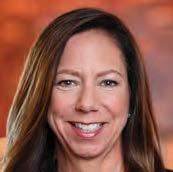


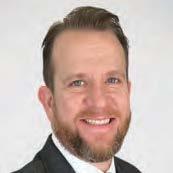








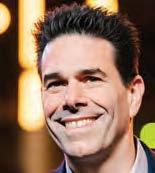


Yes, CTA chief Carter needs to go. But that’s not all.
“T
here needs to be an evolution of the leadership in order for us to get where we need to go with the CTA.”
at’s how Illinois Gov. J.B. Pritzker put it when asked on April 18 whether he has con dence in Dorval Carter, the president of the Chicago Transit Authority since 2015.
When prodded by a reporter for Capitol Fax to clarify whether “an evolution of leadership” meant Carter should be red for his handling of a service that’s struggled for years with crime, cleanliness and understa ng, Pritzker sidestepped: “As you know, I have appointments at CTA, but they’re not a controlling majority. But the people that we appoint, of course, we’ll be working with the others on the board to evaluate and make changes in management.”
Which should make Carter and anyone else in his orbit nervous — except that, inexplicably, Carter and his team have remained in charge at the beleaguered public transit agency despite its shambolic state under his leadership and despite the election of a new mayor, an event that created an opening to reassess whether leaders with better ideas should be put in charge of Chicago’s network of buses and trains.
Carter has somehow for years remained remarkably beyond the reach of public overseers. He is not subject to any sort of formal performance review process via the Chicago Transit Board. He rarely rides the system he oversees. And he only re-

cently appeared before the City Council to discuss the state of a airs at the CTA — an appearance that took place only after council members tried for a year to require him and his team to regularly testify. And as the Chicago Sun-Times notes, he’s the top-salaried sta er under mayoral control, pulling down $376,000 a year — more than 1.5 times the mayor’s salary.
Former Mayor Lori Lightfoot stood steadfastly behind Carter, and her successor, Brandon Johnson, has done the same, waving away public calls from across the political spectrum for change not only at the CTA but at all of the transportation services charged with moving people around the Chicago area.
ose agencies, under the umbrella of
the Regional Transportation Authority, are driving toward a combined scal cli in excess of $730 million as federal COVID relief funding dries up — perhaps as early as 2025 — a reality that could lead to massive cuts to service combined with signicant fare increases that will only further undercut ridership.
Since Pritzker’s remarks, the calls for Carter’s ouster have grown louder — and indeed, it’s past time for him to go. But make no mistake: Merely changing managers in the middle of a lousy season isn’t enough to turn a losing ballclub into a winning one. And it’s the same at the CTA. What’s needed now — and what both Pritzker and Johnson should be advocating — is a comprehensive review of the entire structure of the Chicago area’s public transportation infrastructure. It’s increasingly obvious the region’s prepandemic needs aren’t matched to the current reality. e hybrid workforce is the new normal. What kind of transportation services are needed? What can the region a ord? And does the current, balkanized system of competing agencies — the CTA, Metra and Pace — make sense anymore?
e Chicago Metropolitan Agency for Planning in December released a set of recommendations to x public transit funding, beef up oversight, and improve the experience of riding buses and trains, pitching $1 billion or more in new public funding annually. CMAP’s game plan can at least be a starting point for that muchneeded broader conversation.
In 1999, my mother got a $400 gas bill, and we had a hole in the roof we couldn’t a ord to x because she made $10 an hour.
So our gas got shut o , and for over a year I had to boil water to take a bath. at sticks with you. It becomes part of who you are. at’s why it’s my mission to lower family utility bills with clean-energy technology.
My rm, 548 Enterprises, is a 100% African American-owned Chicago company that proves every day that clean energy is affordable energy and that clean jobs are good-paying jobs, especially for people in Black and Brown communities.
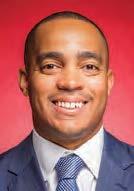
For our rst development project in Chicago, 548 rehabbed three mixed apartment/commercial buildings on 79th Street, where solar power and other energy-e ciency adaptations will yield at least a one-third reduction in energy bills for the 54 tenants. at reduction keeps this quality housing a ordable for our residents and delivers a double-digit return for our investors.
548 is building six- ats on the South
Side; developing 60 housing units and a grocery store in West Humboldt Park; converting an old Bronzeville commercial building to 50 lofts with solar power, and working with developer Related Midwest to build a 302,000square-foot solar-powered training center on Roosevelt Road in North Lawndale.
I support the Clean & A ordable Buildings Ordinance, or CABO, under consideration in the Chicago City Council. It’s a commonsense step toward connecting Chicagoans to all-electric new buildings, which are cheaper to build and cheaper to maintain. Newly constructed electric buildings will have lower energy bills than fossil-fuel buildings because heat pumps are far more e cient than your father’s old boiler, and they work well in Chicago’s cold climate.
Energy Futures Group’s 2022 report on Chicago found that residents living in all-electric new multifamily and singlefamily homes could see energy bill savings upwards of $1,000 in the rst year alone. at’s real money, real savings.
Smart companies are already building all-electric in Chicago.
e new Salesforce Tower, one of the largest commercial building developments in Chicago, was built to be all-electric. Google’s highly anticipated redevelopment of the iconic ompson Center also is planned to be built all-electric to align with the company’s ambitious goal to operate on 24/7 carbon-free energy by 2030.
Building new with gas in 2024 is like shoveling coal in your basement was in the 1940s: Both are dirty and expensive. It’s time Chicago moves on and helps lead the nation to cleaner, more a ordable ways to heat and cook in our homes, with new technologies that create thousands of good-paying jobs. CABO does just that.
Right now, more than 12,000 workers in Chicago are already making buildings cleaner and more e cient — twice as many as those employed in buildings powered by fossil fuels. Jobs in the clean-building industry range from replacing old insulation in homes and tting buildings with new pipes for heating and cooling to installing electric stoves and heat pumps.
And here’s the best part: Most cleanbuilding jobs do not require a college de-
gree. On average, 80% of these jobs provide health care, and annual wages range from an average of $57,700 for installers to an average of $83,100 for electricians. ose positions aren’t just jobs; they are careers with good pay and great bene ts, all available without the expense and debt of a four-year college degree.
e 548 training project at 4300 W. Roosevelt Road has already created 250 temporary union construction jobs in North Lawndale; will create 250 permanent jobs when completed this fall, and will rely on state-of-the-art renewable-energy technology and train hundreds of young Black and Brown men and women every year to support the demand for these high-paying clean-energy jobs.
From a business standpoint and an equity standpoint, CABO is a no-brainer.
A yes vote by council members means yes to lower energy bills, to good-paying jobs and to real opportunities for young Black and Brown people in every part of Chicago.
A no vote on CABO is a vote against opportunity, a vote against equity and vote to keep Chicago from moving forward.
e City Council needs to come together and pass CABO now.
Street
that skips bike and bus lanes says a lot about the entire city
We are on the cusp of a historic redesign of the Chicago Avenue and Halsted Street intersection by the city Department of Transportation, and the choices are about a lot more than just some red paint, concrete and bollards. How we design these streets will determine not just how Chicagoans move through these corridors, but where we are moving as a city.

I’ve taken the 66/Chicago and 8/Halsted buses through these corridors many times. I’ve ridden my bike through every turn of this intersection innumerable times and crossed it on long runs and walks through the city. ese are choices that thousands of Chicagoans make daily, particularly those who have made those bus routes among the most well-utilized in the city.
We’re making transportation choices that reduce both congestion and emissions, a necessity in a city where 29% of our climate emissions come from transportation. Thankfully, we have an infrastructure design vocabulary that facilitates these being safe and comfortable choices: It’s called Complete Streets, a reconceiving of our public way in which all users get equitable space. I was proud to chair a February committee meeting at which our new CDOT commissioner eloquently outlined what this design paradigm shift could mean for Chicago.
Unfortunately, the design CDOT is considering for this intersection fails to live up to the values and the vision of Complete Streets. e current iteration offers no bus lanes on Halsted and no bike lanes on Chicago, while new developments propose to open new curb cuts on both streets, further impeding bus, bike and pedestrian safety. e only clear imperatives for these streets seem to be two lanes for car tra c in each direction.
For anyone biking down Chicago or who has watched the Halsted bus crawl toward them from Grand Avenue, we know that our existing infrastructure is already insufficient. It will become only more insufficient with the significant developments proposed: Bally’s new casino on the southeast corner and more than 2,700 residential units from Onni on the northeast. Chicago absolutely deserves and needs thoughtful development, but it must be paired with equal-
ly thoughtful infrastructure.
As a member of the Plan Commission, how do I vote for a development with 2,751 bike parking spaces when it is unsafe to bike to or from the development? As alderperson of the 1st Ward, I have to wonder why our taxpaying residents funded bus-only lanes on Chicago Avenue through participatory budgeting in our ward, only to see service grind to a
halt at Halsted?
The design of these streets will be finalized soon, with construction slated to start by the end of this year. What we choose to build will either encourage thousands of Chicagoans to embrace public transit and micro-mobility or abandon it altogether. Let’s hope, for the sake of our present and our future, that we make the smart choice.


It’s no stranger than alcohol-free beer’s growing popularity, according to a Chicago roaster
coffee brewing by hand.”
On a trip to Colombia last year, Weihong Zhang was given a “mysterious bag of co ee” by his friend Francesco Sanapo, a three-time Italian Barista Champion. is was not quite as suspect as it might sound: Weihong is the owner of BlendIn Co ee Club, a roastery with a pair of cafes in Houston. Mysterious bags of co ee are kind of his thing.
With its notes of eucalyptus and strawberry, Weihong assumed the bag contained expensive beans like anaerobically fermented Geishas or Sidras. But Sanapo revealed something much more rare for a co ee of this quality: It was ca eine-free.
“It completely opened my eyes to decaf,” Weihong recalls. He decided to use the beans, a basic typica variety from Finca Los Nogales in Colombia, in his upcoming appearance in Rancho Cucamonga at the US Brewers’ Cup, a competition that “highlights the craft of filter
He won. It was the rst time in the competition’s 20-year history that a decaf co ee had taken the title.
Such an unlikely victory isn’t quite the same as winning the Tour de France on a unicycle. But a comparison to the so-called Judgment of Paris in 1976, in which California wines prevailed in a blind tasting against established French vintages, isn’t so far o . e event upended perceptions of American wines and ushered in a new era of global wine production.
As Sergei Kutrovski, who with his brother Mark runs Mirror Coffee Roasters in Bellingham, Washington, put it on their podcast analyzing the rami cations of this victory: “I feel bad for people who tattooed ‘Death Before Decaf’ with, like, the grim reaper.”

fee than typical grocery store fare.
In 2022, Erin Reed, the director of marketing for Swiss Water Decaffeinated Co ee, told co ee industry publication New Ground that “decaf growth has largely been outpacing regular [co ee] growth over the past ve years.”
In an email, Reed con rmed that “this growth trend still holds. And is even stronger within the specialty segment,” referring to artisanal roasted, higher-quality cof-
Decaf has long been the subject of derision and jokes within the co ee industry and out. But it has quietly continued to grow in both quality and popularity. Skyquest Technology predicts that the decaf market will grow, from $19.5 billion in 2022 to $28.86 billion by the end of the decade.




Sales of Blue Bottle Co ee’s Night Light Decaf blend put it in the “top ve blends in both our cafes and online,” according to Matthew Longwell, the brand’s global director of co ee and beverage.
With alcohol-free cocktails and meat-free hamburgers all the rage, decaf doesn’t seem such a strange proposition, says Adam Paronto, a founder of Chicago’s Reprise Coffee Roasters.
“People want their drugs without their drugs,” he says. “I hear this phrase all the time, and it’s like: People want their rituals, but they don’t want it to mess them up where they can’t function normally, whether that be their job, or socially or whatever.” Renewed and re-brewed
New techniques in ca eine removal have played a key role.
e process dates back to the early 20th century in Bremen, Germany, when Ludwig Roselius noticed that co ee beans accidentally soaked in seawater had lost most of their ca eine content while losing little avor. In 1906, he patented a process that involved steaming co ee beans to open their pores. en he switched to using benzene (now known to be a carcinogen) as a solvent to remove the ca eine and established Ka ee HAG (Ka ee-HandelsAktiengesellschaft) to sell his deca einated co ee.
Other solvents, such as methylene chloride—also a carcinogen—eventually replaced benzene and became integral to what became known as the European Method of deca eination.
Organizations such as the Clean Label Project recently petitioned the California Assembly and the US Food and Drug Administration to prohibit use of the substance, which has already been banned by the EPA in products like paint strippers. e National Co ee Association has pushed back, arguing that all of the samples tested by the Clean Label Project were within the FDA’s level of concern.
A process for removing ca eine from co ee without the use of chemicals was developed in Scha hausen, Switzerland, in the 1930s. Swiss Water Deca einated Co ee Inc. has re ned that method into a proprietary process in which green co ee is immersed in green co ee extract, during which 99.9% of the ca eine is released and ltered out. (In the US, removal of 97% of the ca eine is enough for a co ee to qualify as deca einated; in the European Union, 99.9% must be removed.)
While it is generally considered to preserve the taste of co ee better than other methods, the method is relatively expensive. It adds $1 to $2 per pound to the cost of the green co ee, says Paronto— not to mention travel and time to the process, because deca eination takes place at Swiss Water’s facility in Delta, British Columbia. In recent years, another process using ethyl acetate has been gaining popularity. e chemical can be used in a synthetic form or derived naturally in what is often called the “sugarcane method.” In either case, the beans are steamed to open their pores and then soaked in a solution containing ethyl acetate, which bonds to caffeine molecules before being ushed.
The coffee Weihong used was decaffeinated via a modified version in which the pulp, or mucilage, of the coffee berry is added to the fermented sugarcane solution. “It’s a groundbreaking way to do the decaffeination,” he says, because “it not only doesn’t take out any flavors, it imparts nuanced complexity into the cup.”
On April 12, Weihong planned to try his hand in the World Co ee Championships at the Specialty Co ee Expo in Chicago. Regardless of the outcome, things are changing quickly. He thought he had a six-month supply of Los Nogales decaf, but it sold out within a week of his victory at the US Brewers Cup. e next batch, a Castillo variety, is slated to arrive at the end of the month.
Ranked by 2023 revenue; e = Crain's estimate (in gray) ResearchbySophieRodgers(sophie.rodgers@crain.com).|Mostinformationisfromthecompanies.FiguresestimatedbyCrain’sareproducedusingvarioussourcesofinformationaboutthecompanies andtheirindustries.ThelistincludescompaniesbasedintheChicagoarea:Cook,DuPage,Kane,Lake(Ill.),Lake(Ind.),McHenryandWillcounties.StateFarmandcertainotherlargecompaniesoutside those counties are also included. NR: Not ranked last year. e. Crain's estimate. 1. Company estimate. 2. From Moody's; for 12 months ending October 2023. 3. From American Lawyer.
ResearchbySophieRodgers(sophie.rodgers@crain.com).|Mostinformationisfromthecompanies.FiguresestimatedbyCrain’sareproducedusingvarioussourcesofinformationaboutthecompanies andtheirindustries.ThelistincludescompaniesbasedintheChicagoarea:Cook,DuPage,Kane,Lake(Ill.),Lake(Ind.),McHenryandWillcounties.StateFarmandcertainotherlargecompaniesoutside those counties are also included. NR: Not ranked last year. e. Crain's estimate. 1. As
ResearchbySophieRodgers(sophie.rodgers@crain.com).|Mostinformationisfromthecompanies.FiguresestimatedbyCrain’sareproducedusingvarioussourcesofinformationaboutthecompanies andtheirindustries.ThelistincludescompaniesbasedintheChicagoarea:Cook,DuPage,Kane,Lake(Ill.),Lake(Ind.),McHenryandWillcounties.StateFarmandcertainotherlargecompaniesoutside those counties are also included. NR: Not ranked last year. e. Crain's estimate. 1. Company estimate. 2. Formerly Information Resources Inc. (IRI).
ResearchbySophieRodgers(sophie.rodgers@crain.com).|Mostinformationisfromthecompanies.FiguresestimatedbyCrain’sareproducedusingvarioussourcesofinformationaboutthecompanies andtheirindustries.ThelistincludescompaniesbasedintheChicagoarea:Cook,DuPage,Kane,Lake(Ill.),Lake(Ind.),McHenryandWillcounties.StateFarmandcertainotherlargecompaniesoutside those counties are also included. NR: Not ranked last year. e. Crain's estimate. 1. Company estimate.
ResearchbySophieRodgers(sophie.rodgers@crain.com).|Mostinformationisfromthecompanies.FiguresestimatedbyCrain’sareproducedusingvarioussourcesofinformationaboutthecompanies andtheirindustries.ThelistincludescompaniesbasedintheChicagoarea:Cook,DuPage,Kane,Lake(Ill.),Lake(Ind.),McHenryandWillcounties.StateFarmandcertainotherlargecompaniesoutside those counties are also included. NR: Not ranked last year. e. Crain's estimate. 1. From American Lawyer. 2. Company estimate. 3. From PR Week. 4. From Moody's; for 12 months ending June 2023.
Perkins&Will, Chicago
The Chicago of ce of global architecture and design rm Perkins&Will announces the promotion of award-winning designers
Lara Leskaj, IIDA, LEED AP, Interior Design Director, Chicago to Principal, and Kristin Rosebrough, AIA, LEED AP BD+C, Cultural and Civic Practice Leader for the Midwest region, Chicago, to Principal.


Leskaj brings experience in Corporate, Healthcare, Higher Education and Hospitality including clients such as the University of Cincinnati, Washington University School of Medicine, American Express and several Con dential Law and Private Equity Firms. Rosebrough brings experience across all practice areas including projects for the Smithsonian Institution, Morningstar, Inc., Northwestern University and Mansueto Of ce.
ARCHITECTURE
SCB, Chicago
Kahler Slater, Chicago
Wintrust Financial Corporation, Rosemont
Arbor Lodging Partners, Chicago
STRATEGIC ADVISORY
Burwood Group, Chicago

Kahler Slater is pleased to announce the promotion of Joseph Sinnett, AIA to Vice President. As Vice President and Team Leader, Joseph will continue to lead projects across the country for the rm’s residential and hospitality clients including build-to-rent, mixed use, residential multi-family, and soft brand and full-service hotels. He will also help to guide the rm’s long-term direction and strategies for growth and operational excellence.
Featherstone, Inc., Downers Grove
Wintrust Financial Corp., a nancial services holding company based in Rosemont, Illinois, with more than 170 locations across Illinois, Indiana, and Wisconsin, is pleased to announce two appointments.
Russ Larsen will be appointed to Market Head. Russ will oversee the Northwestern region, which includes three of Wintrust’s 15 charters. Russ will celebrate 12 years at Wintrust in July.

Larsen

Stickney
Jon Stickney was appointed CEO at Barrington Bank & Trust Company, N.A. Jon will continue growing the business and developing the next generation of leaders. Jon will celebrate 24 years at Wintrust in June.


Renee Sprogis-Marohn, AIA has been named Chief Operating Of cer at SCB. Renee, who joined SCB in 2011, has been integral to the growth of the rm’s aviation practice, managing the design and delivery of United Airlines’ Clubs and Polaris lounges in over 25 airports worldwide, and the success of SCB’s interior design practice. She joins the executive leadership team overseeing operations across the rm’s of ces in Chicago, San Francisco, Boston, and Seattle.
SCB, Chicago
Featherstone, Inc., a professional, full-service, project and construction management rm, welcomes Michael Swain as Director of Business Development and Operations. He brings over 25 years of industry experience in the development of commercial, industrial, and retail construction. Michael will use his experience in leadership, management, and strategic planning to serve the growing Featherstone team and focus on providing our valued clients with superior service.

Buoyant Ventures, Chicago

Wintrust Financial Corporation, Rosemont



Jonathan Orlove, AIA has been promoted to Principal at SCB. With over three decades of experience managing awardwinning projects across a variety of sectors and project types throughout the world, Jon also assumes the role of Managing Director in the rm’s Chicago of ce.
SCB, Boston
Buoyant Ventures, a climate tech venture fund in Chicago, announces the hiring of Alex Behar as a Principal Investor. Mr. Behar will source, diligence, and lead investments at Buoyant. He previously worked at Cultivian Sandbox where he was a Vice President focused on food and agriculture investments. Earlier in his career, Mr. Behar was a consultant for Deloitte in Johannesburg, South Africa, working with clients in the food, agriculture, and energy industries.


Paul Schlapobersky, AIA, LEED AP is promoted to Principal and Director of Planning and Urban Design. As both a planner and architect, Paul continues SCB’s long tradition of integrating the two disciplines to create visionary and actionable plans across all scales, from cities to districts to campuses. Based in the rm’s Boston of ce, Paul works across all four of the rm’s of ces on projects nationwide and around the globe.

B. Riley is pleased to welcome Virginia Schnippel as Managing Director with the rm’s Corporate Advisory & Valuation Services practice. She brings signi cant valuation expertise and industry experience to her clients with over 23 years of experience supporting domestic and international M&A, recovery and reorg, tax and other valuation-related advisory work.
Virginia is also an Accredited Senior Appraiser (ASA) with the American Society of Appraisers.
World Business Chicago announces the appointment of Vamsi Bonthala, CEO & Co-Founder, Arbor Lodging Partners, to its distinguished board of directors. World Business Chicago is committed to fostering inclusive and equitable economic development through business growth and expansion, workforce development, and community impact. World Business Chicago also promotes the city and region as a premier global hub for business and innovation.


Prairie Capital Advisors, Inc., Oakbrook Terrace

World Business Chicago announces the appointment of James Hart, President, Burwood Group, to its distinguished board of directors. World Business Chicago is committed to fostering inclusive and equitable economic development through business growth and expansion, workforce development, and community impact. World Business Chicago also promotes the city and region as a premier global hub for business and innovation.


Wintrust Financial Corp., a nancial services holding company based in Rosemont, Illinois, with more than 170 locations across Illinois, Indiana, and Wisconsin, is pleased to announce two promotions. James Swabowski assumed the role of SVP, Division Manager, Commercial Banking at Village Bank & Trust Company, N.A. James will celebrate eight years at Wintrust in May. Dominique Sawko was promoted to EVP & General Counsel at First Insurance Funding. Dominique joined Wintrust in February 2011.
Prairie Capital Advisors, Inc., a leading corporate advisory and investment banking rm, is pleased to announce it has hired Yuhi Kamimura as Director. Mr. Kamimura will be part of the Oakbrook Terrace, IL of ce and will focus on advising middle-market companies, shareholders and trustees on employee stock ownership plan (ESOP) transactions, fairness opinions, leveraged buyouts, capital raising, mergers and acquisitions (“M&A”) and other strategic advisory engagements.


Skadden, Arps, Slate, Meagher & Flom LLP, Chicago
RedShelf, Chicago
Crafty, Chicago
Mara Jones joins Crafty as the organization’s rst VP of People. With 10+ years of experience, Mara will be scaling up the company’s employee experience, national hiring strategy, and people operations. Before joining Crafty, she served as the VP of People & Culture at Kasa and the VP of Recruiting for The Bay Club Company, where she was a signi cant contributor to each company’s growth.



Skadden recently announced that Rachel E. Cohn has been promoted to partner in the Corporate group. Ms. Cohn focuses her practice on mergers and acquisitions, corporate governance, shareholder activism and SEC and other regulatory compliance issues, as well as a range of other corporate and securities matters. She has advised public and private companies in a variety of sale and acquisition transactions. Ms. Cohn is based in Chicago.
Skadden, Arps, Slate, Meagher & Flom LLP, Chicago
Skadden recently announced that Ralph E. Pérez has been promoted to partner in the Mergers and Acquisitions group. Mr. Pérez concentrates on mergers and acquisitions, with a focus on private equity transactions, primarily in the energy, chemicals, infrastructure and manufacturing industries. He also counsels clients on a broad range of corporate matters in Latin America. Mr. Pérez is based in Chicago and Houston.


Holland Fenton
RedShelf, the Chicagofounded innovation leader in course materials solutions, announced that tech industry veteran Rob Holland will replace company co-founder Greg Fenton as Chief Executive Of cer. Holland joined RedShelf as President in January 2023 after successfully scaling multiple technology companies in the ad tech, martech & eCommerce industries. As President, Holland led the development of the revolutionary Cascading Access course materials delivery platform and the move to a new headquarters at 175 W Jackson Blvd. RedShelf is well-positioned for growth with differentiated new technology and marquee university customers. Fenton will now serve as RedShelf’s Board Chair, focusing on strategy, innovation, and industry relations.

To order frames or plaques of profiles contact Lauren Melesio at lmelesio@crain.com
There's a slew of new restaurants ready to host your events — and we've curated the best of the crop. Here are nine places you can book for a casual business lunch, a post-work happy hour or a more formal affair.
By | Ari Bendersky
228 E. Ontario St., 312-471-3883
The private space can seat up to 50 people or accommodate 80 for a reception.
Decor: The Albert restaurant converted an infrequently used loft space into a stylish Sicilian pizza and wine bar and — boom — a great concept was born. Dark slatted tiles cover the oor, white tables pair with sleek brown leather chairs and recessed lighting peeks from a cool overhead wood shelving unit housing books and other knickknacks, all helping to set the mood for a casual event.
Cost: No minimum; packages run $30 to $75 per person.

Cuisine: Sicilian-style pizzas. The concept, created by The Albert executive chef Steve Chiappetti, showcases his favorite type of pizza: light, crisp and airy Sicilian style. The menu, set up family style or as a buffet, starts with the choice of two antipasti, like burrata drizzled with balsamic vinegar and topped with roasted tomato or Calabrian chili-rubbed shrimp topped with herbed focaccia crumbs. Then select three pizzas from a choice of six. That could be the Sicilian Crunch with balsamic-glazed mushrooms and roasted garlic; the Verdure with sweet peppers, mushrooms, onions, crushed San Marzano tomatoes and provolone cheese; or smoked duck with toasted pine nuts, goat cheese and caramelized onions. Add in dessert like chocolate budino or a cookie cart, and throw in a wine tasting showcasing 10 varieties for an additional $25 a person, and you've got yourself a party.
Note: Food and beverage minimums don’t include tax or tip. Prices and menu items should be considered representative and are subject to change.
748 N. State St., 773-569-3522
The second- oor event spaces can accommodate from 20 up to 80 seated guests and 90 for a reception.

Cuisine: New American. Similar to its sister restaurant, Gemini Lounge in Lincoln Park, the menu here features elevated comfort food where you'll truly nd something for everyone. Work with the events manager to craft an event ranging from a family style dinner to a cocktail reception to a seated plated dinner. Options include big-eye tuna crudo with pickled blueberries and leche de tigre; lightly battered lump peekytoe crab cake; little gem Caesar salad with brioche croutons; chorizo breadcrumb-topped seared sea scallops; roasted chicken frites with thyme jus; wagyu skirt steak with Bordelaise sauce; and an 8-ounce prime burger with Monterey Jack, grilled jalapeño relish and roasted shallot aioli.

Decor: Stepping inside Ballyhoo Hospitality's newest restaurant, across from Holy Name Cathedral, you'll bypass the main- oor racetrack bar and head upstairs (ADA accessible by elevator). Here you'll nd two event spaces: the Superior Room and the State Room, which can be combined for larger gatherings in a space with the feel of a private members-only club. The intimate State Room, set off by wood and glass doors, has a 20-seat, 34-foot live-edge wooden table surrounded by half-moon cushioned wood chairs. The table is set below two dramatic chandeliers and atop a beautiful oral area rug. Celadon green wood walls add warmth. The Superior Room features a full bar, darker wood tables with half-moon cobalt leather chairs, globe pendants and fabric banquettes that run beneath a panel of wallpaper with a vintage feel.
Cost: Minimum pricing varies from lunch to dinner. The State Room starts at $1,000, the Superior Room starts at $3,000 and a full second- oor event starts at $6,000.
2100 N. Halsted St., 773-770-3402
The private dining room can hold up to 27 people.
Decor: The intimate back room of this newer family run Thai spot in the heart of Lincoln Park beckons with slatted wood wainscoting, leather and metal seating, wood-topped tables, framed art, hanging lights and various plants. A small private bar adds to the affair, as does the "Let's celebrate" yellow neon sign hanging on the wall. Cost: No minimum spend; the restaurant can customize a prix xe menu starting at $39 per person, including appetizers, entree and dessert.


Cuisine: Thai. Here you'll nd traditional Thai dishes with a modern bent. The prix xe menu starts with a mix of appetizers like spring rolls, crispy tofu salad with creamy peanut sauce, tom yum soup or the house fried chicken. Shared entrees include pad Thai with shrimp, chicken ginger stir-fry, braised beef Massaman curry, crispy stir-fried pork and stir-fried sushi-grade garlic salmon. Finish it off with Thai custard or fresh coconut ice cream. And yes, the restaurant has full bar service.
2114 N. Halsted St.
A private room can accommodate up to 24 seated or 32 standing guests.
Decor: Saunter through the bright and airy Lincoln Park storefront accented by a soft orange glow and white marble-topped bar toward the back of the intimate space. Here you'll nd a whitewashed brick room illuminated by a set of skylights. Wooden tables with leather-stitched stools set below local art warm up the space where a solo plant peeks out from the corner. The minimal decor was created by owners and chefs
Adam McFarland and Thomas Rogers.
Cost: Price varies depending on day and time.




307 N. Green St., 312-500-1128
A variety of private spaces can accommodate from 22 seated guests up to 300 for a cocktail reception.
Cuisine: New American. There's a reason people patiently line up at John's to order before being guided to their table: The oft-changing, beautifully plated dishes explode with avor. Work with the chefs on either a prix xe menu or one with a minimum spend. While the American dishes sound simple in description, they are anything but in taste and presentation. You might nd a hamachi tartare with Kalamata olives and fried capers; ricotta gnocchi with sweet Italian sausage and sherry cream sauce; or branzino with a carrot beurre blanc. And the eclectic wine list, from General Manager Jonas Bittencourt, is always thrilling, and picking wine with him is an adventure in the best way.


Decor: La Serre translates to "the greenhouse," and that quickly becomes obvious with the numerous plants and greenery throughout the space. Antiqued oralpatterned wallpaper, oral-laden seat cushions, copious oral arrangements, vibrant tile design and light woods beckon. One of the private rooms, with windows looking over Fulton Street, offers exposed brick, glass pendants and greens descending from above.
Cost: Minimum spend for each space varies by day, time and season.
Cuisine: Coastal French. Provence and the Mediterranean coast come alive through the food here, whether served at stations or family style. Start with bites such as crab croquettes, tuna crudo, oysters on the half shell, French onion tartine and mini lobster rolls. Larger portions like gnocchi Parisienne, prime rib, Dover sole or a seasonal Provencal sh selection complete the meal.
1516 W. Carroll Ave., 312-896-4410
The private secondoor room can accommodate up to 175 seated or up to 200 reception guests. A rst- oor space can seat 12.
Decor: Enter through the main restaurant (ADA accessible by elevator) or via a private entryway to the well-lit room on the second oor. The main focus here, other than the food, is a library of antique books curated by Paper or Plastic, a partner in the building's collective businesses.
Brick, hardwood oors, glass and metal windows, a few plants and a small sitting nook with two leather club chairs all add to the ambiance. You'll also have access to a private outdoor patio, ideal for mingling in the warmer months.
Inquire about the Third Season Room, just off the main dining room. This daytime cafe and apothecary can host up to 12 guests in a seated private gathering.
Cost: Minimum spend is $2,000 to $6,000, depending on the day of the week.


Cuisine: Contemporary American. It's hard to pigeonhole the food at Maxwells. Sure, it has American in uences, but you'll nd a bit of a Southern accent mingling with Asian, Italian and Midwestern in uences from executive chef Chris Jung (Momotaro) and partner Erling Wu-Bower. Start with appetizers like uke tartare, lamb kofta kabobs and wood-grilled mushrooms with ve-spice tofu. Then settle in for a three-course dinner ($75 per guest) in which you choose from a variety of items off the restaurant's main menu. If you've heard about the mouthwatering French onion dip, the soon-to-be-famous bruleed sweet potato with yogurt or the simply grilled, chimichurri-adorned bavette steak, you can get them for your soiree.
445 N. Dearborn St., 312-363-3335
A private dining room can hold up to 12 people.
Decor: Imagine dining in your friend's cozy and rustic dining room at their villa in the Italian countryside and you have an idea of what to expect here. A simple wood table with high-backed chairs sits next to oorto-ceiling windows. A set of nine nooks holds ephemera like books, bud vases, small ceramics and more. Hardwood oors and a few plants help add warmth.
Cost: $100 per person; a 50% deposit is required at booking.

Cuisine: Italian. This New York import has everything for your celebrazione. Start with a selection of carne e formaggio: mortadella, pecorino, prosciutto and gorgonzola dolce. Then add in various crudo and focaccia before getting into plates of pasta: chitarra alla carbonara with guanciale; spaghetti all'astice with lobster meat and cherry tomatoes; ravioli di carcio (artichoke). Round it all out with roast chicken with green pea puree and asparagus; 8-ounce tenderloin; and grilled branzino with roasted fennel, olives and capers.
333 N. Green St., 312-900-0033
A private dining room can accommodate up to 50 people.


Decor: A main feature of the spacious room are the gorgeous, intricate, vintage-style Asian tapestry wall coverings that almost feel like they're telling a story to entertain you and your guests. Rattan-backed chairs, paper lantern pendants, mixed tiles, bamboo and loads of greenery add more warmth to a room that is fully private behind sliding glass doors with blackout curtains.
Cost: Minimum pricing varies by day, time and availability.

Cuisine: Tuscan steakhouse. Acclaimed Los Angeles chef Evan Funke (Felix, Mother Wolf) drew inspiration mostly from central Italy, namely the Tuscany region, to create the menu highlighting pasta (pici cacio e pepe or tagliatelle al ragu, anyone?), handcrafted in his on-site pasta lab, and the famed 60-day, dry-aged 42-ounce bistecca alla Fiorentina. You'll also nd other Italian fare such as focaccia with rosemary, sea salt and drizzled extra virgin olive oil; braised beef short rib meatballs; blue prawns resting in salsa verde; and roasted Green Circle chicken with wild mushrooms and sugo d'arrosto, a traditional Piemontese sauce.
Cuisine: New Asian. Like the original in River North, Sunda's menu pulls from Japan, China, Thailand, Vietnam, the Philippines and beyond. Your menu can include spicy tuna crispy rice; achiote-glazed chicken inasal with lemongrass and a chili-lime vinaigrette; sweet misoglazed black cod; "the great white" escolar with truf e vinaigrette, potato chip and black truf e shavings; Korean fried chicken steamed buns; baked snow crab handrolls and more.
401 E. Wacker Drive, 312-725-1724
The four private rooms can accommodate 14 to 60 people, depending on the space.

Decor: Expect elegance throughout the entire restaurant, no matter where you choose to host your event. Whether in one of the three smaller spaces that can combine to one large room to host 60 people, the mezzanine (for up to 40 guests) overlooking the restaurant with perfect views of the Chicago River through 40-foot windows or the intimate 14-seat boardroom, you'll nd dark woods, plush curtains, low lighting and a sophisticated ambiance.
Cost: Prices vary depending on space and date, and minimums can range from $1,800 to $10,000. The menu starts at $135 per person and features a multi-course shared menu.

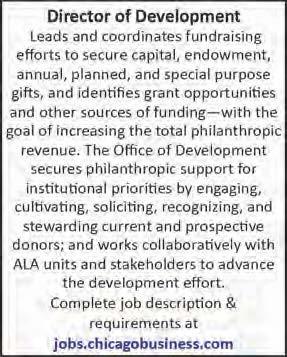


From Page 1
bill to the education committee. Instead of a one-page brief, she handed out binders to each member.
“Her debates on the floor or in committee were something to marvel at, because she was always really well informed and able to defend her position with facts,” Aquino said, adding that Pacione-Zayas liked to reference her “receipts.”
Johnson plucked PacioneZayas out of the 20th state Senate district seat. Pacione-Zayas’ former district director, Graciela Guzmán, will carry on her old boss’ progressive legacy after beating Iris Martinez’s appointed successor, state Sen. Natalie Toro, in the March primary. During her swearing-in ceremony in 2021, Pacione-Zayas told her fellow state senators, “You can count on me to . . . advance an anti-racist framework that dismantles systemic racism and economic exploitation so we can all thrive.”
Her pledge reflected her work in education: She holds a Ph.D. in educational policy studies and worked at the Erikson Institute for four years. It also illustrates the vision she shares with the mayor. That philosophy focuses on what Pacione-Zayas calls “re-centering power,” whether it’s with Senate legislation repatriating Native American remains or Johnson administration initiatives like paid time off.
Addressing inequities
The rhetoric she employs mirrors that of the mayor himself — underscoring their shared view that city government's function is not merely to fill potholes and haul away garbage: It has a role to play in righting historic wrongs that still plague America's cities. The challenges Johnson and Pacione-Zayas now face together — from immediate worries like curbing crime as the Democratic National Convention nears to longer-term questions such as the future of downtown — are likely to put their beliefs to the test.
“Our current systems and structures were designed to privilege particular populations and their proximity to whiteness,” she said in an interview with Crain's, explaining how an “antiracist framework” applies to politics. At a systemic level, she contends, these policies have especially disadvantaged Black people.
“We are looking at something at the root cause and at the systemic level, so that no matter who is in power, who is in that formal authority, it can outlive that,” she said. “But, ultimately, constructing these solutions with the people who are closest to the problem so that they can really drive how we are deliberate about redistributing resources, about meeting the explicit needs for populations, but also acknowledging the history and the barriers that have existed, and constantly interrogating who is burdened and who is beneting.”
Echoing the language that swept Johnson into o ce, Pacione-Zayas contends Chicagoans can’t reside in a scarcity mindset: ere’s enough for everyone.
“There is a false dichotomy that when you are centering individuals who have been harmed the most by the status quo, that somebody has to lose,” she said. “In fact, I look at it as more additive and we are multiplying our power. This notion that somebody has to lose because somebody else is gaining, it really does not serve anyone and it continues to keep us divided.”
When the nascent Johnson administration announced the hiring of Pacione-Zayas and City Hall veteran Guidice, the pairing appeared as a compromise that would please both the mayor’s progressive base and those who yearned for an establishment voice in his cabinet. Guidice’s experience at the Office of Emergency Management & Communications also boosted confidence that the city would be equipped with the logistics and security know-how to prepare for the Democratic National Convention in August. When asked how she would assuage concerns that Guidice’s recent departure meant the mayor’s team wouldn’t have someone on board with that same level of emergency or operational experience needed for the convention, Pacione-Zayas pushed back.
“It doesn't acknowledge that there are individuals as a part of the cabinet who have distinct areas of expertise,” she said, ticking off a list of cabinet members. They include Jose Tirado at the OEMC, city COO Roberson, city Corporation Counsel Mary Richardson-Lowry, Deputy Mayor of Business Kenya Merritt and Deputy Mayor of Infrastructure Lori Ann Lypson.
“To basically say all knowledge and skills were in just one person diminishes every other individual I just named, and every other individual who may not have been in city government but brings a wealth of talent and experience,” she said. “We're grateful that Rich was with us for the 11 months because he really laid a firm foundation, developed tools, structure, systems and a cadence of communication that we can continue to build on.”
Pacione-Zayas’ progressive roots come from her Puerto Rican father and Italian mother. Born in Lincoln Square, Pacione-Zayas’ family later moved to Logan Square. Her home away from home was the Logan Square Boys & Girls Club, where her parents rst met as youth workers in the 1970s. When Johnson approached her for the job in his administration, she saw it as a historic opportunity for a Chicago kid whose family came from public housing and relied upon government services.
“I grew up in the club, from a baby all the way through elementary school, until my mother became disabled and there was
obviously a radical shift in our family,” said Pacione-Zayas, whose mother still uses a wheelchair. “Ultimately, observing my parents doing a lot of the work, that has very much informed my disposition to work and that is creating safe spaces for young people, negotiating gang truces, ensuring that families have their basic needs met and ultimately modeling a sense of social responsibility.”
Social justice movements dominated her childhood. Her parents took her in tow to meetings and protests expressing solidarity with Palestine, Black Chicagoans, the LGBTQ community and disability advocacy. Puerto Rico’s relationship to the U.S. government also informed her political mindset, a story that’s reflected among her peers on the left, such as Ald. Rossana Rodriguez-Sanchez, 33rd, and her former co-chair at the Puerto Rican Agenda of Chicago, 26th Ward Ald. Jessie Fuentes.
“ e Puerto Rican community in Chicago has deep roots in the left and the resistance against colonialism,” Rodriguez-Sanchez said. “ e people who organize the most and with the most success are the people that express care, the people that have values that are very rooted in community and not in individualism.”
Pacione-Zayas’ own family moved to the U.S. in 1954 so they could access care for her uncle, who was born without limbs as a result of birth control experiments performed on PacioneZayas’ grandmother. The ethics of the pill trials in Puerto Rico, funded in large part by philathropist Katharine Dexter McCormick, have been compared to the U.S. government’s Tuskegee syphilis study. When her family arrived in Chicago, they settled in public housing at Lathrop Homes, an area now gentrifying into a series of white-washed, riverfront apartments.
In times of crisis, Pacione-Zayas has helped mobilize Chicago’s Puerto Rican diaspora. After Hurricane Maria hit the island in September 2017, she and other members of the Puerto Rican Agenda fundraised $650,000 in donations. With the help of then-Congressman Luis Gutierrez, Mayor Rahm Emanuel and United Airlines, the organization sent a cargo ight lled with supplies to the island. ose supplies arrived before the Federal Emergency Management Agency could help, Pacione-Zayas said. e group’s relationships with mayors on the ground, particularly the mayor of San Juan, allowed them to move emergency supplies into the interior where they were desperately needed.
“ at rst plane that went to Puerto Rico with aid, that was a push from Cristina Pacione-Zayas mostly,” said Rodriguez-Sanchez. ey loaded the cargo plane with pallet upon pallet of electrical generators, phone chargers and baby formula. Hurricane relief e orts stretched from 2017 to 2018, but it didn’t mark the end of the Puerto Rican
Agenda’s work on the island. Earthquakes battered Puerto Rico again in 2019 and 2020, shaking the island’s foundation and the mental health of its residents. In its wake, the Puerto Rican Agenda activated psychologists and sent more funds, a mission PacioneZayas hopes to mirror with Johnson’s "Treatment Not Trauma" plans.
Even as those relief efforts gave Pacione-Zayas a crash course on logistics, she counters that Puerto Rico’s emergency and the current migrant crisis in Chicago are not the same. Her original title in the administration may have been “deputy chief,” but for all intents and purposes, Pacione-Zayas is Johnson’s quarterback on the migrant crisis, with Beatriz Ponce de León, the city’s deputy mayor of immigrant, migrant and refugee rights, as her right hand.
“What we are managing here in the city is deliberately designed to invoke chaos,” Pacione-Zayas said.
Migrant point person
Unlike a natural disaster, Pacione-Zayas points out that the migrant crisis has been fabricated by Texas Gov. Greg Abbott as well as former President Donald Trump’s economic sanctions on Venezuela, which motivated people to flee the country.
A look at the numbers shows a staggering toll on Chicago’s re-

sources and on the migrants who have ed north. More than 38,600 migrants have arrived in Chicago since August 2022. By April 5, 9,680 people were staying in 21 shelters across the city, a downgrade from the height of the crisis, when over 13,000 were housed in 26 shelters this past November. As of that date, the city had spent $299 million with over $206 million going toward Favorite Healthcare Sta ng, a Kansas-based contractor whose deal with the city became a ashpoint for rates that some Johnson critics termed "exorbitant" as well as its use of out-of-state labor.
No municipality has ever been expected to manage an international humanitarian crisis that the federal government should handle, Pacione-Zayas argued.
“So that's a very di erent thing,” she said. “Because now we are having to adapt our physical municipality to meet the demands of more than 37,000 individuals eeing the conditions . . . from their home countries and really seeking a better life, but not having an anchor community that can absorb and support, nor having any federal intervention that is commensurate with the size of this particular issue.”
On Zoom calls with reporters, in City Council hearings and inside testy community meetings over the placement of migrant camps, Pacione-Zayas has taken
heat from Chicagoans upset with an overwhelming humanitarian emergency. But City Council members have borne the brunt of their constituents’ animosity. As the situation reached a boiling point last October, protesters angry over plans for a base camp in Brighton Park attacked 12th Ward Ald. Julia Ramirez.
“Even though we didn’t see eye to eye, she was being really inspiring, trying to help me see the bigger picture. . . .She was very considerate about the things that were happening,” Ramirez said of Pacione-Zayas. “I think those two things can exist and I just want people to know that about her. Even though it was a hard time, she was never neglecting what I was going through on the ground.”
Annie Gomberg, a volunteer with the Police Station Response Team — a network of Chicagoans who pulled together to meet the needs of migrants when many were being housed in police stations — expressed frustration with Johnson’s management of the crisis and skepticism of Pacione-Zayas’ progressive bona fides after the administration renewed contracts with Favorite Healthcare. Still, she admires Pacione-Zayas’ work and is cautiously optimistic about her new role in the administration as the mayor's chief of staff.
“She’s very operations-minded and I think she does have a
respect for complexity,” said Gomberg, who added that she has not seen a compassionate approach from the city’s Office of Emergency Management & Communications. “The idea that we’re taking care of people because it is the responsibility to care for people is something that I think CPZ brings to the table and her background certainly speaks to.”
e city has closed shelters as the number of arrivals has dropped, but that also means pushing migrants out of that temporary housing. After the city instituted a 60-day shelter stay limit in March, 66 migrants have been forced to leave shelters.
Pacione-Zayas and other members of the administration take issue with the term “evictions” in the context of the migrant crisis. She argues that “evictions” refer to apartments and housing, whereas the city is housing migrants in emergency shelters and has connected them with case managers to put them on a path of self-sufficiency.
“Is the mission perfect? No. Are we doing the best we can? Absolutely. Can we be doing more? Yes,” Pacione-Zayas said. “But we also need people to partner with us. And have we been able to stand in our values, meet the moment as well as be scally responsible? Absolutely.”
Even those who have criticized the Johnson administration’s handling of the migrant crisis point to Pacione-Zayas as a stabilizing force and a reassurance for progressives. Ald. Andre Vasquez, 40th, has used his Committee on Immigrant & Refugee Rights chairmanship as a pulpit to denounce the administration’s eviction policies. Yet, he believes Pacione-Zayas has been thorough and worked in good faith.
“It's not lost on me that having her as possibly one of the only Latina voices out of the leadership, obviously Deputy Mayor Ponce de León as well, but having women and Latinas that are in leadership I think is helpful in the migrant mission,” Vasquez said. “I think about what it would be like not having somebody of the same culture and upbringing and not having an understanding of what that experience is like.”
Pacione-Zayas may bring a unique voice to the Johnson administration, but there’s no daylight between her overarching policies and the mayor’s.
“One of my colleagues had said, ‘It's so wonderful to be a part of a group where we don't have to explain poverty,’ ” Pacione-Zayas said. “We understand the forces, the structures that created it, and what we are now in a position to transform and change.”

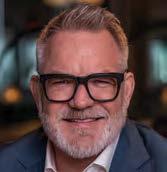














planned manufacturing district, has remained largely unchanged.
It’s not clear why the boatyard development did not move forward, and Sodiko did not respond to a request for comment.
R2 CEO Matt Garrison said the property’s ownership venture needed to recapitalize and opted to sell it, using the proceeds to pay off a loan tied to the site and redirect capital into another project across the street at 1001 N. North Branch St. R2 had previously planned to convert the historic former Peck & Hills Furniture warehouse at that address into a 250,000-square-foot office building.
But Garrison said the sluggish office sector has pushed the developer to pivot and turn the property into an “urban flex” building with industrial, warehouse and office space for a wide range of possible users, such as photography studios, fitness facilities or retailers that need on-site storage or production space.
“We believe that there’s a big market out there for what loft buildings used to be 25 years ago,” said Garrison, whose real estate firm owns and has redeveloped several prominent properties on Goose Island.
Garrison said R2 plans to move its own office to the 1001 N. North Branch building and that a couple other tenants have signed on. A source close to the project said the developer is in talks with Sodikoff to lease close to 40,000 square feet in the six-story building for Hogsalt’s
From Page 3
“Edith was like a sidebar; she was a footnote,” he added.
Two decades later, Farnsworth, a Chicago physician and medical professor who got Mies to design her a second home and then battled him in court over cost overruns, is getting praise as the knowing patron of an architect who, though he revolutionized high-rise architecture, did few houses and none as serenely beautiful as hers.

main office and other local operations. Hogsalt is well-known locally as the group behind restaurants including Au Cheval, Gilt Bar and Bavette’s.
An R2 venture acquired the boat yard property in 2014 for just more than $8.2 million, according to property records, and the developer continued to operate it as a boat yard for a few years. It’s unclear what Perillo has planned for the northwest portion of the site, which includes a single-story building. A Perillo spokesman did not provide a comment.
e boatyard property sale expands the Goose Island footprint for BA Investment Advisors, which paid $17.5 million last
since 2010, after being managed by Landmarks Illinois in its first several years as a public asset.
It was meant to be the elegant country house that one erudite artistic woman asked for “in this wonderful natural landscape she enjoyed,” Mehaffey said. The house, on 62 acres in Plano, 58 miles southwest of Chicago, inspired New York architect Philip Johnson’s design of his famed glass house in Connecticut.
Giving Farnsworth her rightful credit extended to renaming the landmark in 2021 to include her rst name, rewriting the script of tours that 10,000 visitors a year hear and complementing the gift shop’s “It’s All About Mies” T-shirts with a shirt that labels her “Fearless.”
Farnsworth’s profound connection to the wooded site on the edge of the Fox River kept her focused on ensuring that whatever Mies built there, it should have a similar affinity for its surroundings.
Michelangelo Sabatino, an architectural historian and professor at the IIT College of Architecture
“It was not meant to be a monument to Mies,” said Scott Mehaffey, executive director of the Edith Farnsworth House, which has been a site of the National Trust for Historic Preservation
It also includes the rst-ever publication of the two chapters of Farnsworth’s handwritten memoirs in which she details “from the Sunday morning that she woke up and decided she needed a little bit more of an escape on the weekend,” Sabatino said, “to the moment she decided to sell” the house about two decades after it was nished.
spring for the eight-story former Kendall College building at 900 N. North Branch — immediately southeast of the boat yard property — as well as a 2-acre parking lot across the street.
Show of con dence
at purchase was a show of con dence in the future of Goose Island and its environs. Across the street from the former Kendall building, Canadian real estate rm Onni Group plans to redevelop a former Greyhound bus maintenance facility property with nearly 2,700 apartments. e sites are also just north of the Chicago Tribune’s Freedom Center property, which casino giant Bally’s
Sabatino transcribed the chapters, which are housed at the Newberry Library, and included them in a book Monacelli Press will publish in June, called “The Edith Farnsworth House: Architecture, Preservation, Culture.”
From the chapters, it becomes clear, Sabatino said, that “Edith was deeply engaged with the natural setting. She knew the trees and she knew the land and she was very deeply engaged with them.” Farnsworth’s profound connection to the wooded site on the edge of the Fox River, he said, kept her focused on ensuring that whatever Mies built there, it should have a similar affinity for its surroundings.
The result was a one-room house, 77 feet long and 29 feet wide, with nearly its entire exterior wrapped in glass, a thin separation between indoors and outdoors. It stands on stilts five feet above the ground, which has mostly kept it above rising water levels in the Fox River, but not always.
The architect was imperious, but Sabatino and Mehaffey said the client was confident enough to go mano a mano with him. Mies ordered the furniture he wanted to put in Farnsworth’s house, Sabatino said, just as the architect had done two decades earlier at Villa Tugendhat, a house he designed in Brno,
From Page 3
back and forth,” said Brad Haller, senior partner of mergers and acquisitions at Chicago consulting firm West Monroe. “Everyone feels good about the economy growing, but then inflation has ticked up. It is just a lot of mixed signals.”
More buyers than ever have spotted problems with a target near the end of the due diligence process, with Haller estimating that 35% to 40% of his clients have backed away from a deal after identifying a potential acquisition.
Moreover, the search for a perfect target has raised prices too high for companies that can pass through a buyer’s investigation as the firm looking to be bought has often raised the interest of multiple bidders.
plans to redevelop with the city’s rst casino.
A spokesman for BA Investment Advisors declined to discuss specific plans for the property but said in a statement that the firm “acquired the site strategically as it abuts the property at 900 North Branch.”
BA Investment Advisors is led by investors Jeff Bernstein and Larry Elbaum, co-founders of brokerage Bradford Allen Realty Services. Their investment venture has been one of the most active buyers of office properties in the Chicago suburbs over the past several years, having spent more than $120 million on a series of suburban office properties since late 2020.
Czech Republic.
“Mies told her that the Barcelona chairs would be delivered,” Sabatino said, “but Edith said, ‘I don’t want Barcelona chairs.’” She thought the minimalist lines of modern furniture would make the interior of her house feel “like a clinical place,” he said. “She wanted the atmosphere to be a country house, an inviting place.”
‘In tune with nature’
After Farnsworth sold the house to architecture collector Sir Peter Palumbo in 1972, he filled it with the type of furniture Mies preferred. In 2020, when the house — by then a longtime museum — was temporarily furnished with the Moroccan rugs and other, warmer items that Farnsworth preferred, Chicago Tribune architecture critic Blair Kamin wrote that “the interior seems warmer, more in tune with nature, and above all, more livable.”
Mehaffey said there’s a rotating schedule for the furnishings. When filled with modernist furniture, the house “honors the Palumbo period,” he said, “which was a significant period for the house.” Palumbo’s ownership stretched from 1972 to 2003, a decade longer than Farnsworth owned the house. Farnsworth’s decor will be back in 2026,
“Anything that is available is getting a lot of looks,” Haller said. “It has to be a really cash flow positive business that does not need a lot of additional investment.”
Although most forecasts call for continued improvement in the overall U.S. economic picture, the outlook for the private-equity market remains uncertain following the unful lled expectations of a rst-quarter rebound.
“Six months from now, the psychology should be better,” PitchBook’s Clarke said. “We should have lower interest rates but that was expected to have happened by now. Things are just playing out more slowly for a PE recovery.”
Mehaffey said.
May 1 is the 20th anniversary of the glass pavilion opening as a public asset, but that day was the culmination of a three-year effort. In 2001, when Palumbo first announced his plan to sell, thenGov. George Ryan persuaded Illinois legislators to budget about $7.5 million to buy it. But in 2003, then-Illinois Attorney General Lisa Madigan killed the plan over lack of funding, and preservationists feared the house might be sold to someone who would haul it out of Illinois.
Sotheby’s, the auction company that was handling the sale, “even put out a video showing how you could take it apart and re-assemble it,” Mehaffey said.
In the December 2003 auction, a coalition of preservationist donors and nonprofits, including the National Trust as well as Landmarks Illinois, made the winning bid of $7.5 million. “The sale lays to rest months of fear that (the house) would be sold to a developer and moved from its site,” The New York Times reported. “Preservationists said moving the house, long considered a landmark of domestic Modernist architecture, would destroy the context for which Mies had designed it.”
Farnsworth was mentioned once in the Times story, in the 10th of 18 paragraphs.
This may be the next $12 million-plus home in Winnetka to be demolished and replaced
The North Shore teardown wave has also arrived at the doorstep of an 1850s house in Glencoe that was designed by the architect of Chicago’s historic Water Tower & Pumping Sta tion
Dennis RodkinA picturesque lakefront mansion in Winnetka that sold last summer for more than $12.2 million is likely to become the town’s second $12 million-plus teardown in as many years.
e demolition wave has also come for an 1850s house in Glencoe designed by the architect of Chicago’s iconic Water Tower & Pumping Station and the Joliet penitentiary.
“ ey’re taking down precious pieces of the historical fabric,” said Peter Van Vechten, chair of Glencoe’s Preservation Commission. “Individuals have property rights” that allow them to demolish old structures, he said, but when they do, “they alter the broader context of the village.”
But a builder of dozens of North Shore homes says the teardowns are a consequence of the region’s allure to a uent homebuyers. “You cannot give those old houses big windows, 12-foot ceilings and energy (solutions) like geothermal heat,” said Leo Birov, whose rm, Heritage Luxury Homes, is not involved with these two houses.
Living without those modern amenities is “not what people want when they’re spending the kind of money they spend” to live on the North Shore, Birov said.
It’s no longer a question of how much someone will spend on a property they intend to tear down, since billionaire Justin Ishbia spent $33.7 million for three houses in a row that have all been demolished to make way for the 68,300-square-footer he’s now building.
Instead, the question is “how much more history and character that make (Winnetka) a special place can we a ord to lose,” said Jack Coladarci, who chairs Winnetka’s Landmark Preservation Commission.
“ is teardown trend is a ecting the essential nature of the built environment in Glencoe,” Van Vechten said. In the past three decades, he said, about one in every four Glencoe houses has been torn down and replaced, about 800 houses in all.
In both towns, landmarks boards can only delay, not prohibit demolition. Winnetka’s 270-day delay “is supposed to give us time to try and nd a better opportunity” for the threatened property, Coladarci said, “but we’re only supposed to impose the delay if it looks like there’s a chance (the owners) might change their mind.”
Coladarci acknowledged that there’s a slim likelihood of the present owners of the $12.25 million Sheridan Road house lining up a preservation-minded buyer they could pass it along to.
If torn down, it will be the second demolition of a $12 millionplus Winnetka home in recent


years. e buyers who in August 2022 paid $12.75 million for an early 1900s lakefront house on Sheridan Road signaled their intention to tear it down the day of their purchase. ose buyers used a land trust that conceals their name in public records. Milena Birov, the @properties Christie’s International Real Estate agent who represented them, declined to discuss their plans.
Glencoe
e endangered Glencoe house, built in about 1855 on Lincoln Avenue, was the work of William W. Boyington, one of Chicago’s busiest architects in the decades before the 1871 re, designing a long list of the city’s churches, hotels and commercial buildings.
Shiraz Kotte and Vijay Kotte, the couple who bought the centuryold blu top Mediterranean fantasy in late August, began the process of applying for a demolition permit ve weeks later, and are now going through the approval process with the village’s Landmarks Preservation Commission.
e Kottes did not respond to Crain’s request for comment. Shiraz Kotte, managing director of Chicago-based K4 Capital Group, whose mission she describes on LinkedIn as “investing in disruptive health care innovation,” previously worked as head of pharmaceutical strategy at kidney dialysis rm DaVita Medical Group. Her
bought the house in 1966. He died in 2002, and Jessie died in 2004. Her estate sold the house in 2006 for $8.1 million.
e Glencoe house that faces demolition is far less grand. A ve-bedroom, roughly 3,200square-footer, it has a handsome Victorian facade whose shingled mansard roof wraps two small and one very large dormer. Front porches on the rst and second oors and ample wood trim add to the impression of being “a house of its time, the 1850s,” Van Vechten said.
On the back is a boxy latter-day addition that doesn’t contribute to the historical look.
ere’s little known about what’s planned for the site if the demolition permit gets approved, as Van Vechten said it’s expected to. e lack of information stems in part from a lack of clarity about who’s involved.
husband, Vijay Kotte, is CEO of GoHealth, an online seller of insurance plans, and co-founder at K4 Capital.
At a recent landmarks commission meeting, Coladarci said, Vijay Kotte “said they want to build their dream house” on the 2.2-acre site, which has about 155 feet of Lake Michigan shoreline. e house’s fanciful look, with more than a dozen roof peaks and several chimneys all capped in red tile, “is something everyone in Winnetka has enjoyed looking at,” Coladarci said. In recent years they’d seen less of it, as new streetfront trees grew up to block the view.
e house was built in about 1910 for Lena Gilmore, a widow and real estate investor, according to a Winnetka Historical Society article by Laurie Petersen. e name of the architect has evidently been lost to time. Listing photos before the August sale showed the interior has abundant plaster details in its historical rooms, including ornate decoration on the ceilings and fireplaces, twisted columns and crown moldings. The bathrooms and kitchen had all been updated by the owners who bought it in 2006 and sold it last summer.
For four decades, the house was owned by the family of W. Clement Stone, the insurance magnate and advocate of optimistic thinking. With his wife, Jessie, Stone
e house, which had been on and o the market a few times since 2016, went up for sale again in December with an asking price of $998,000. Since March 18, the listing has been marked “contingent,” meaning the buyer and seller have some details to work out before completing a contract. On the same day, an application for a demolition was led, listing as the property owners Edward Fox and Robin Grinnalds and as the contracted purchaser a legal entity called Northern Developers.
Fox and Grinnalds, who are attorneys with o ces in the city, bought the house for $712,000 in 2003, according to the Cook County Clerk. In May 2023, a transferon-death document was recorded in Grinnalds’ name. at’s 10 months before her name was recorded on the demolition application as an owner.
Fox did not respond to a request for comment.
e contact for Northern Developers listed on the permit application, Magdalena Rechul, declined to comment.
ere’s a clue to what Northern Developers might have in mind for the Lincoln Avenue site about seven blocks away on Adams Avenue. ere, the rm purchased a run-of-the-mill Georgian in May 2022 for $560,000 and demolished the house. e ve-bedroom, 4,500-square-foot modern farmhouse Northern Developers built on the site sold in October for $2.1 million.
Van Vechten said he doesn’t complain when undistinguished houses get torn down. In the case of the Lincoln Avenue house, he’s holding out hope for a compromise, such as a builder agreeing to protect the historical parts of the house and build new in back, where there’s now an addition that could be removed.
“A compromise,” Van Vechten said, “would be a win.”
Let ’s rise to the challenge, Chicago.
Only a hunger-free community can really be healthy. When we help feed our neighbors, we truly become a greater Chicago.

Please give now.
chicagosfoodbank.org/rise